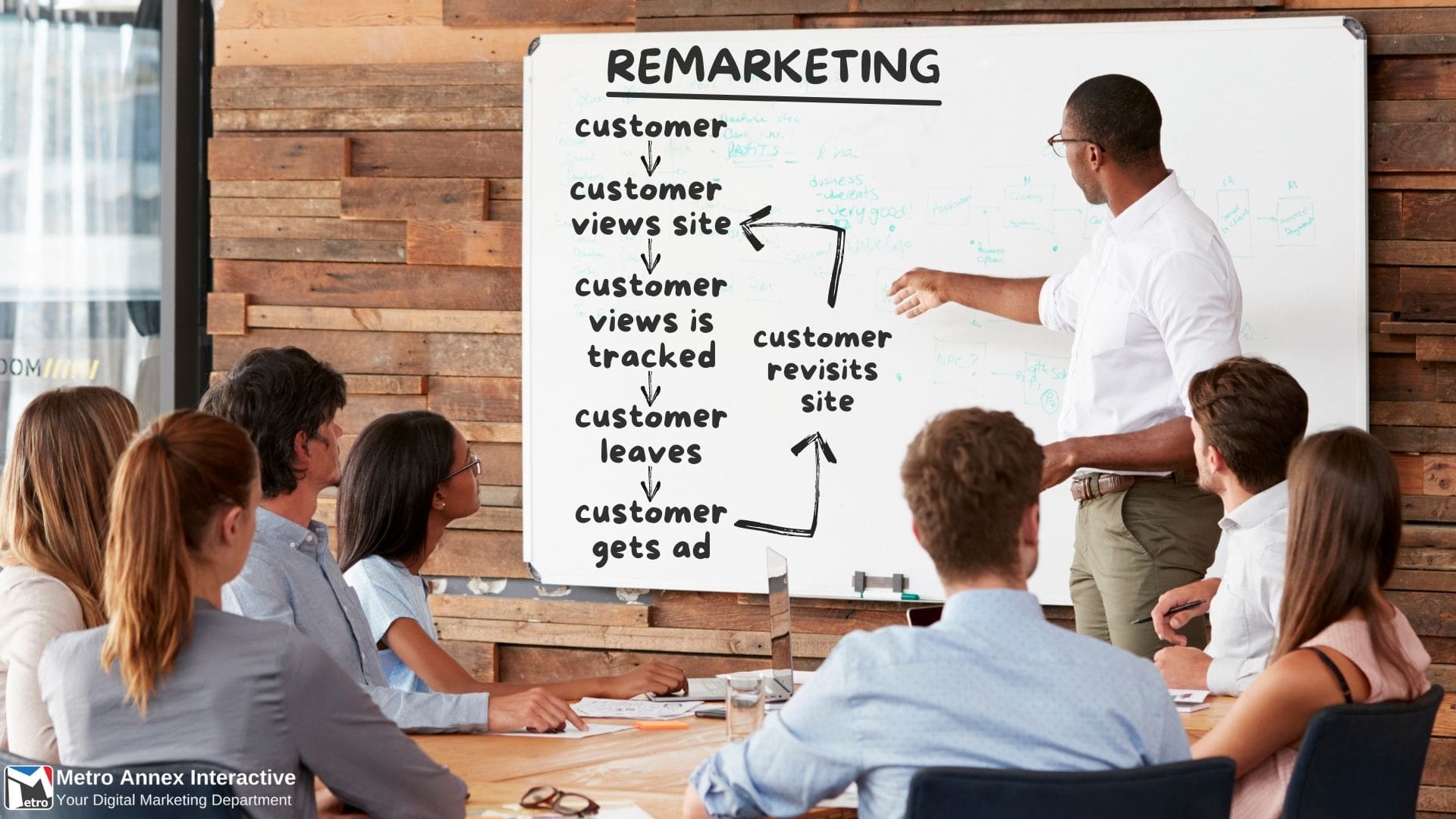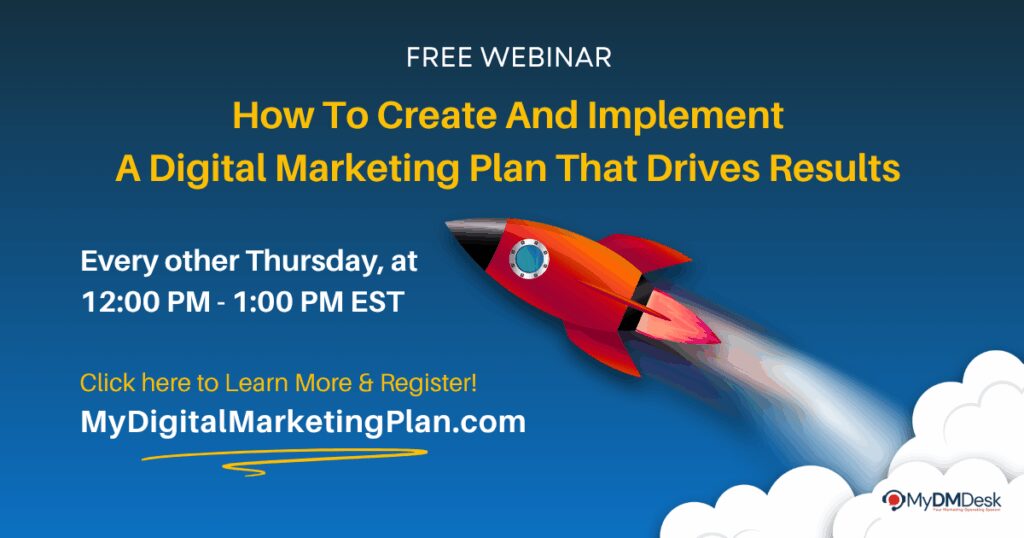Marketeering Blog
Remarketing Your Potential and Existing Customers

Are You Remarketing Your Website Visitors?
You likely have many visitors that check out your website to view your services or products but do not commit to make a purchase or take any action. Obviously, they seemed interested. So, how do you get them to come back? That’s where remarketing comes in; using email and ads to convince potential or existing customers to give your business a second look.
What is Remarketing?
Have you ever viewed a particular product or service online or placed items in your cart but did not hit the checkout button? And a day or two later you’re back online and suddenly, there are ads popping up for those very same items? Or you’re receiving emails from the businesses you visited? If so, you’ve been remarketed!
Also known as retargeting, remarketing is a digital marketing tool to reach out to website visitors and reengage them. It’s all about pulling them back to your website and converting them into paying customers.
Related Article: Post-Covid Marketing Strategies
How Does Remarketing Work?
So, just how does remarketing your potential or existing customers work?
You can set up a remarketing campaign on your website. This involves using an ad network that adds tracking code, known as a pixel tag, on your site. When someone visits your website or webpage for the first time, the code launches cookies.
The cookies have the visitor’s anonymous and unique identification. This allows the visitor’s website activity to be tracked so you can remarket them.
Here’s an example. You visit an electronics store website to check out a particular television set, but do not buy it. A cookie on that website grabs your information and the website you visited. Later, when you are visiting another website, an ad from that store featuring the TV you were looking at will be displayed. This is an attempt to remind you of your interest in the store and the product and get you to buy it.
Just What is a Cookie?
As explained by Norton, cookies are small text files that websites save to your browser. These files contain data about you and your online browsing activity.
“There are two main types of cookies, first-party and third-party,” says Norton. “First-party cookies live on the site you are visiting. Third-party cookies originate from a site that you are not currently on. It is these third-party cookies that are also known as tracking cookies because they track you as you roam the internet.”
These tracking cookies are responsible for sending targeted ads to websites or webpages visitors view. The goal is to get visitors to return to the sites previously viewed to buy the products or services that were clicked on.
The cookies store a list of websites visited as well as the pages viewed. They also track the products and services viewed and purchases made. The visitor’s IP (Internet Protocol) address and location are also tracked. Cookies are the main tools when it comes to remarketing your potential and existing customers.
Using Technology for Remarketing Your Potential and existing Customers
So, when someone visits your website, two cookies are generated that will capture the visitor’s IP address, location, and the pages, products/services that were clicked on. The first-party cookie stays on your site that gives you the visitor’s information so you can remarket them. The third-party cookie follows the visitor as they surf the web and launch your ad – keeping your business name and your offers in front of them.
Thanks to the remarketing technology, you can actually follow your visitors as they browse the net and send ads to them. You can not only target them about the services or products they expressed interest in, but you can also use the information to market other promotions or even local events. Leave it to technology to help with remarketing your potential and existing customers.
Laws Limiting Tracking Cookies
Those third-party cookies may be coming to an end, however. Google recently announced that it will ban the use of third-party cookies on its Chrome browser in 2022. Safari and Firefox have already ditched them.
Additionally, federal laws have been enacted requiring companies to inform website visitors that cookies are being utilized and giving visitors the option to disable them to avoid being tracked.
According to Hubspot, with Chrome accounting for 56% of browser users, Google’s move will impact marketing.
The first-party cookies will still be allowed, though, so all is not lost. You will still be able to gather basic visitor info and remarket to them.
Remarketing Ad Platforms
Outbrain has these ad platform suggestions for remarketing your potential and existing customers:
- Simple display remarketing – The most simple and popular type of remarketing. Just display an ad to people on other sites after they have visited yours, on display ad networks like Google, Yahoo and Bing.
- Native remarketing – Marketers can re-engage their website visitors with valuable content, recommended across premium publishers in native ad placements.
- Search remarketing – Remarketing lists for search ads (RLSA) is a feature that lets you customize your search ads campaign for people who have previously visited your site.
- Social media remarketing – Show your retargeting ads to people on social media platforms like Facebook, Twitter, and LinkedIn after they’ve visited your website.
If you have a limited advertising budget, remarketing potential and existing customers is a great way to increase your ROI (Rate of Return).
Related Article: Creating Effective Online Advertising
Email Remarketing
Email is a great way for remarketing your potential or existing customers. Campaign Monitor notes that email marketing influences nearly 60% of consumers’ decisions to make purchases.
When a visitor signs up for a lead magnet on your site – such as seeking information about something or an offer – they provide their email address so you can send it to them. With their email info in hand, you can now begin a highly targeted campaign.
Here are some email marketing tips from Campaign Monitor:
- Utilize email segmentation – This is the process of splitting up your emailing list into more detailed, highly targeted lists. It helps you further target those who are looking for specific information and ensures that you aren’t sending emails to those who’ve already purchased a specific product or taken another specific action (such as downloading a report, etc.).
- Time matters – You’ll want to start sending your email retargeting emails right after someone’s clicked off your website entirely. The sooner you land in their inbox, the more likely they are to return to your site and reconsider the service/product that they passed up initially.
- Help re-engage inactive subscribers – If you’ve noticed an increase in your inactive subscribers, using email retargeting is a great way to remind these subscribers why they subscribed in the first place. The idea is to remind them of what piqued their interest in the first place and encourage them to reconsider acting on a Cal To Action.
Related Article: Promoting Your Business with Email Marketing
What is a Remarketing List?
This is a list of those who visit your website. According to Think with Google, you can create separate lists for ad campaigns. These would be for those who just visited your homepage. Other lists would be for those who clicked on a particular page or product/service on your site.
This allows a more targeted campaign, so you have a better chance of having the visitor return to your site.
Attract Paying Customers
Remarketing is a cost-effective and successful way for remarketing your potential and existing customers. Since you are targeting those who have shown an interest in what you offer, you have a greater chance of conversion than will-nilly advertising and emailing.
Let the Professionals Help!
A marketing agency is your best bet to develop a marketing funnel for your business. You need to focus on your day-to-day operation, so let us do the marketing for you. Metro Annex Interactive has the time and experience to design strategies and plug any leaks that may develop in the funnel! We can help you with remarketing your potential and existing customers. Schedule a FREE Consultation to learn more.
Article Resources
FREQUENTLY ASKED QUESTIONS
What is remarketing, and how does it work?
Remarketing is a digital marketing strategy that targets users who have previously interacted with your website or mobile app. It works by placing cookies on the users’ devices when they visit your site or engage with your content. Later, when they browse the internet or use social media, they are shown targeted ads that remind them of your products or services, encouraging them to return and complete a purchase or take another desired action.
Why is remarketing important for businesses?
Remarketing is important because it allows businesses to keep their brand in the mind of potential customers who have shown interest but have not yet converted. It also helps to increase the lifetime value of existing customers by promoting repeat purchases. It’s a cost-effective way to improve conversion rates and re-engage with audiences.
Can remarketing be personalized for better results?
Absolutely. Personalized remarketing campaigns are more effective as they are based on the specific products or content that users showed interest in. By tailoring ads to reflect the preferences and past behavior of users, businesses can increase the relevance of their messages and the likelihood of conversion.
What platforms can be used for remarketing?
Remarketing can be carried out on various platforms, including Google Ads (previously Google AdWords), Facebook and Instagram Ads, Twitter Ads, LinkedIn Ads, and other programmatic advertising networks that allow for retargeting.
How do businesses ensure they are not overexposing users to ads through remarketing?
To prevent overexposure, businesses can set frequency caps on how many times a user sees an ad over a given period. They can also use segmentation and targeting controls to ensure that the ads are only shown to users under specific conditions, such as those who haven’t visited the site recently or who left items in their shopping cart.
Is remarketing GDPR compliant?
Remarketing must be GDPR compliant by respecting user privacy and data protection standards. This includes obtaining explicit consent from users to track their behavior for advertising purposes, providing clear information about data collection, and giving users the option to opt out of remarketing cookies.

Mathew Phillips | Digital Marketing Specialist
Mathew Phillips is an expert in digital marketing and lead generation services. Mathew has a passion for all things digital marketing from website design and search engine optimization to digital advertising, email marketing and social media.
FREE 2024 DIGITAL MARKETING GUIDE
Stay Ahead of the Curve with Expert Insights and Monthly Marketing Tips
Boost Your Lead Generation
You’re one step closer to increasing your qualified leads.







